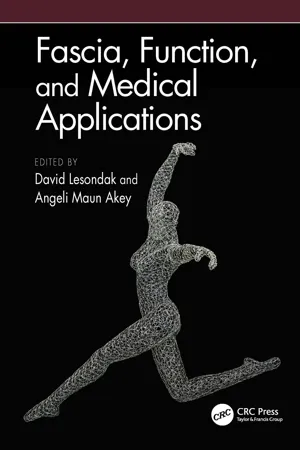
Fascia, Function, and Medical Applications
David Lesondak, David Lesondak, Angeli Maun Akey
- 279 pages
- English
- ePUB (mobile friendly)
- Available on iOS & Android
Fascia, Function, and Medical Applications
David Lesondak, David Lesondak, Angeli Maun Akey
About This Book
Fascia, Function, and Medical Applications is essential reading for medical and allied health practitioners who want to bring scientific insights of the importance of fascia to human health into their clinical practices.
Fascia – the biodynamic tissue that connects every muscle, bone, organ, and nerve in the body – is fast becoming the latest trend in healthcare and allied health modalities. This book is edited by David Lesondak, University of Pittsburgh Medical Center, author of the international bestseller Fascia: What it is and why it matter s, and Angeli Maun Akey, MD, international physician educator and board certified in both internal and integrative medicine. It contains contributions from a team of top researchers and expert practitioners including physicians, clinicians, therapists, dissectors, and surgeons.
Fully illustrated in color, this book presents the latest scientific knowledge of fascia and explains insights into problems like chronic pain and myriad musculoskeletal symptoms that may not respond to conventional treatments. It gives practitioners the information they need to make better decisions to improve the health of patients often without pharmaceuticals or surgeries.
FEATURES
• Provides comprehensive overview of how fascia, as a tissue and a system, affects various body functions and systems, from musculoskeletal disorders to nervous system, circulatory, and auto-immune function.
• A section devoted to medical applications highlights a comprehensive and critical overview of various fascial therapies.
• Gives practitioners the knowledge they need to refer or add as an adjunct therapy to their department or rehabilitation team.
This is a cutting-edge, practical guide that will appeal to researchers, physicians, and clinicians alike.
Frequently asked questions
Information
Section III
Medical Applications
Interstitial Notes on Section 3
David Lesondak
“SOMETHING IS MOVING”
REFERENCE
13 | Structural IntegrationMichael Polon and Daniel Akins |
BACKGROUND
STRUCTURAL INTEGRATION IN THEORY
Table of contents
- Cover
- Half Title
- Title Page
- Copyright Page
- Table of Contents
- Preface
- Coeditor Preface
- Acknowledgments
- Editors
- Contributors
- SECTION I Fascia
- SECTION II Function
- SECTION III Medical Applications: Interstitial Notes on Section 3
- Index